A Learning Community for Parents & Teachers of young, BIPOC children

EmbraceRace is pleased to announce the launch of Color-Brave: An Early Childhood Learning Community of/for Adults Nurturing Resistance & Joy in BIPOC Children.
If you missed the informational webinar about this new community, you can still watch the recording. In it, our Color-Brave Community Facilitators, Keeley Bibins and Darcy Heath, join Andrew and Melissa to introduce the community and to invite parents, caregivers and educators raising or teaching at least one BIPOC child 0 to 8 years old to join.
Can you or the friends/family members/colleagues you forward this information to still join the group, even if you missed the initial information session? If you/they are raising, teaching, nurturing at least one BIPOC child between the ages of 0 and 8, the answer is YES!
Together, we're looking to build an online community of learning and practice where adults learn from and with each other to create spaces that nurture Black and Indigenous children and children of color (BIPOC children) who are resilient, resistant, and joyful in the face of whatever racialized (and other) challenges they may face. Supporting adults to raise all children to thrive, together, is the larger work of EmbraceRace. The Color-Brave Community will focus on the needs of young BIPOC children because our society doesn't devote nearly enough care and resources to those needs AND because so many EmbraceRace community members have asked for this space.
The Color-Brave Community will be what its members, all of us, make it. Are you ready to engage?
- Watch the video for more information
- Join the Color-Brave Community private Facebook group - there you'll meet your peers, participate in moderated discussions and learn about monthly webinars and weekly Zoom discussions.
- Email your questions and ideas for this community to colorbrave@embracerace.org
- Read more about the Color-Brave Community here
- The transcript of the taped presentation and conversation follows.
EmbraceRace, Melissa:
I want to start by saying if you don't know us already, we are the co-founders
of EmbraceRace. I am Melissa Giraud, a multiracial Black, White mom.
EmbraceRace, Andrew: And I'm Andrew Grant-Thomas. I identify as Black or African American. I am a dad of the same children that Melissa is mom to.
EmbraceRace, Melissa: Yeah, so they are upstairs. We're partners in life as well. EmbraceRace is a community of support for caregivers, parents, teachers, child facing professionals, of folks that want to raise, nurture kids who are informed, brave, and thoughtful about race.
We work mostly with kids who are, or families who have middle school-aged and younger aged kids. Tonight, we're talking about an initiative that's really geared at families that have kids that are zero to eight years old - and teachers and educators, who are teaching at least one child of color - Black, Indigenous, Asian, Latino. That's what we're talking about tonight. Andrew will introduce our partners in this work.
EmbraceRace, Andrew: I am going to introduce Keeley Bibins and Darcy Heath, who will be the facilitators for this community that we're launching tonight. And that we hope many or all of you will be interested in not only learning more about, but participating in. Your participation will make this as strong as valuable as we hope it will be.
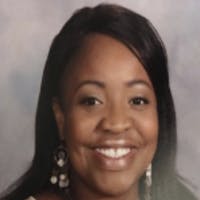
Let me start with Keeley Bibins, who is a passionate advocate for children. Professionally, Keeley is an educator who began her career as an Inclusion Pre-K teacher in a predominantly African American Title I school. Keeley is currently an Educational Facilitator for the Buffett Early Childhood Institute, where she provides on-site support through professional development and coaching, to elementary school leaders and teachers, Pre-K through third grade. Keeley is a proud mother of three young Black men, a 20-year-old, and seven-year-old biracial twins.

Darcy Heath, she/her, is a White, cisgender, able-bodied heterosexual woman. She is passionate about equity, early childhood education on early literacy. Darcy has put those passions to work as a classroom teacher, as an instructional coach, and most recently as a professional learning facilitator. She currently designs and facilitates professional learning, and provides consultation to various early childhood organizations within her home state of Arizona and across the nation, our home state of Arizona. She considers her greatest achievement to be her role as a mother and grandmother. We're trying to convince her that her greatest achievement is to be our friend and collaborator. Really glad to have you both. Wonderful to have you involved in this work.
Let's start where we always do. Both of you have a passion for early childhood education. Why, either from a professional or personal angle, are you invested in this work?
Keeley Bibins: Thank you, thank you. I'm so excited to be a part of this great thing that we're doing here. To talk about my why, I think my biggest why is one, I identify as Black. I was a child that came up in the system that we are bringing our children in. And I'm a mom, right. I'm a mom of, my son is, like you said, 20. I've been very active with him. Also, with my children, my biracial children who are currently in the school system, that we frequently have to help them see the greatness in them. Luckily, I've been an educator, so I kind of know both sides. I can actually advocate for my kids in the teacher language. What I notice is that I have that ability, but I'm thinking also about all the other children who may not or other parents who may not have that ability because they're not educators and they're not in both worlds.
My children are like my guineapigs for my work. That's horrible, but it is. I use my life and the things that I go through with my children to say, "There are other parents like me. There are other teachers like me. How can I use my experiences to better situations or better the pathways for our children and their success?" That's really my why, is because I am really passionate about our children and giving them the best opportunity that we can, and really maintaining their innocence, and reestablishing it if I can. That's kind of what I've given my life to. I'm so excited to be a part of this.
EmbraceRace, Andrew: We're so glad that you're a part of this effort and bringing all of that advocacy. I love that word, that's huge. We need to advocate for ourselves, right?
Keeley Bibins: Yeah.
EmbraceRace, Andrew: And learn how to do it effectively.
Darcy, why are you invested in this work?
Darcy Heath: Hi, Andrew and Melissa. It's so exciting to be here and to be able to work with you all and launch this. Though being your friend will probably never be my greatest achievement, it's in the top 10, maybe the top 20. All right? All right.
EmbraceRace, Andrew: Top 20 is good.
Darcy Heath: My why is pretty big, and it starts with my role as an educator. I graduated from college with my teaching degree, and I entered the classroom. It did not take me very long to figure out I wasn't prepared for the students who were in my classroom. I had zero classes, zero training, on how to be culturally diverse. How to be relevant for all the students in my classroom. Looking at the data, I knew that there was inequities. I knew that we had inequities in outcomes. We have inequity in discipline.
I made it my passion and my responsibility to educate myself. Of course, that started with me. It started with unpacking my own culturalization, my own identity, my own implicit biases and how it showed up in my classroom as an educator. How it showed up in my interactions with children and families. Then as I left the classroom and I became an educational facilitator coaching other teachers in preschool through fifth grade, many of them who were like me and identified as White. Many of them who, like me, had zero training. I saw it showing up in their classrooms too. I saw it showing up in the schools there as well. So, I continued to learn and grow and provide that support. I continue to do that now as I provide professional facilitation for learning in the early childhood field. Again, as you said, in the state of Arizona, which is my home base, as well as with organizations across the United States.
I'm very blessed to do what I do. But my real personal interest in it, and why I'm here, and why I'm so excited about this space, is my role as a grandma or a "Mimi" to two beautiful biracial Filipino and White children. My grandson is five and a half. My granddaughter is two and a half, and they have amazing parents. My son and daughter-in-law are phenomenal, and they are raising these children to be proud of their identities. To be joyful and resilient and resistant. I want to do everything I can to support them. I'm here both as an educator and as a family member of young Filipino American children, or Filipino White grandchildren.
EmbraceRace, Melissa: That's a big why. You're both engaged professionally and personally. You both have the relationships. Keeley talked about being a mom. Darcy, you're a grandmother to these biracial kids you just mentioned. You have both worn different professional hats that are relevant. I know in our own experience, we've come across some wonderful teachers, but they're standalone. It's individual teachers who decide this is really important. And on top of their typically extraordinarily busy schedules and demands on their time, they're making time to invest and learn more and bring that to the classroom, as oppose to the school, much less the district, really giving them robust support.
I'm wondering what your experience was with gaining support. Where and what kinds of support did you get along the way for your work?
Keeley Bibins: Okay. Well, I will say as a Black teacher, I didn't get a lot of support on how to teach children of color. It was me actually being a parent of children of color and being a woman of color myself that drove me to want to do different things in the classroom. Just like Darcy said, I was a child of color, but I worked with wonderful colleagues, but that was not part of our training. Part of our training that we got being pre-teachers was not, how do you work with different cultures? How do you create an inclusion community in the classroom, where everybody based on color or race, can actually strive in the classroom? That was not part of our training.
So, what I did is I did take some additional classes just as a parent at the parent learning community in my neighborhood. I wanted to take part and become part of that because it was something that was available to my parents. I can't advocate to my parents for something that I didn't know about. When I became a part of this group and this organization, there were some classes that I took that was like how to have a conversation with your children about race. We talked about different studies. I implemented some of those things in my classroom. I can't think of the study, but where we have different dolls of different nationalities. You ask the children as they play, "Which one is the pretty baby?" and the results were astonishing.
Starting to have conversations with my parents about that, but also using that data to show the district that I was working with, our children are identifying race! They identify it, and they notice that the information, the books that you send us, the posters that are in our classroom, don't look like them. They don't represent them. Our kids are starting with a deficit perspective of themselves because there's nothing to show them how great they are just as they are with their different pigments, their different abilities. I had children who spoke Hindu, children who spoke French. One child hated the fact that she spoke French. That broke my heart. I really didn't get a lot of support, but I had to go out and find it. That's why I really want to be part of an initiative that tries to help bring that to the classroom so that teachers don't have to go out and look so hard for it, because it's always beneficial to the students.
Our kids are starting with a deficit perspective of themselves [in the classroom] because there's nothing to show them how great they are just as they are with their different pigments, their different abilities... That's why I really want to be part of an initiative that tries to help bring that to the classroom so that teachers don't have to go out and look so hard for it, because it's always beneficial to the students.
Keeley Bibins
EmbraceRace, Melissa:
I love in that story too, Keeley, that you were going to the parent learning
community in your neighborhood, which sounds amazing. Can I get one of those?
But that you were going because you wanted them to go as well. Just immediately
having fostering that relationship with the parents to teach and guide the kids
around race is really important.
EmbraceRace, Andrew: Darcy, you're now providing that support to others. When you were 10 years as a teacher, where did the support come from for you?
Darcy Heath: It didn't. If I'm being honest, in my 10 years as a teacher, I taught at two different schools in two different states. I do not recall one time ever being offered training or support in how to be inclusive. How to recognize what every student needs, especially Black and Indigenous children of color. It wasn't until I took a position as an educational coach with a program that was setting out to do that. Their mission was to close the race and income based achievement gap. It wasn't until then that I started getting support for my learning.
I was very blessed then and now in my current role to be surrounded by colleagues who are also on their own learning journeys, and who are tremendous supports to me and to early childhood educators out there, who many of them are like me where they don't have any of that support. They don't have access to the learning within their early care sites, within their home childcare sites, within their schools or districts. That's I'd say one of the reasons I think this community is so needed, because there isn't anything like it. Especially there isn't anything like it that brings families and educators together on behalf of children.
EmbraceRace, Melissa: Let's talk about the it.. Of course, in the past 10 to 12 minutes, we're just scratching the surface, of course, of what these two wonderful folks bring to this. But we did want to spend at least that much time because they will be facilitating these community conversations and dynamics. We have a presentation for you. Before I jump to that, is there any last thing you want to touch on?
Keeley Bibins: I think we'll touch on some things throughout the presentation. I'm just really, really excited, like Darcy said, because I've been a teacher and been a parent. I think it's really, really exciting to build this bridge to make things congruent for kids. What they're learning from school and learning at home, and not feel like you have to be one way at home and one way at school. I'm really, really excited for this community to come together and learn from everyone because I'm always a continual learner. I'm continuously learning. I'm really, really excited to be a part of this and bring this together, and to see what happens.
[EmbraceRace begins presentation]
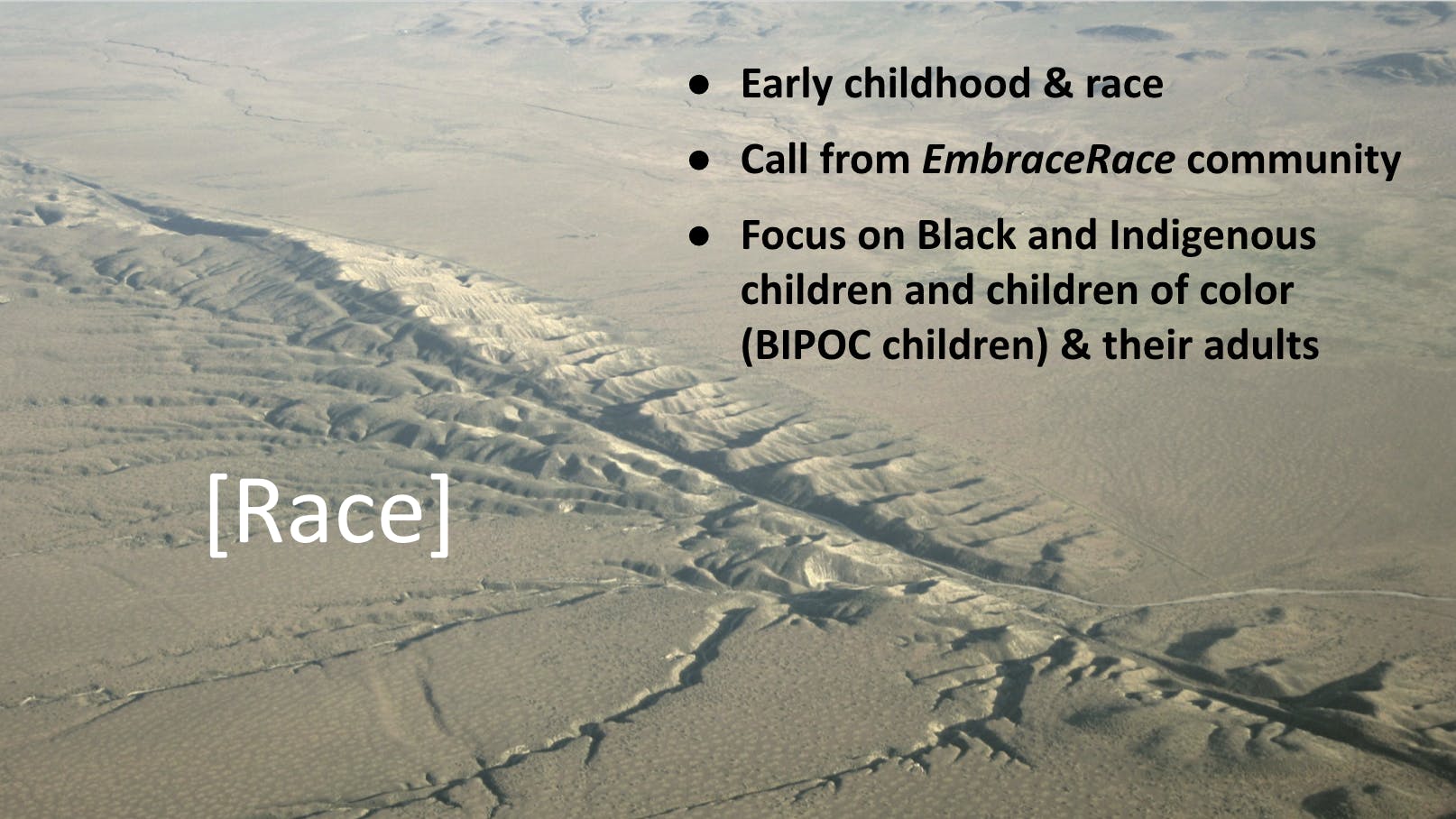
EmbraceRace, Melissa: Okay, so as I said early on, and those of you who know EmbraceRace know that we focus on kind of this fault line for many of us in the U.S. and outside of the U.S. of race and on childhood, middle school and younger. But we wanted to start a learning community that focuses on early childhood. The reason for that is really that it's an incredible opportunity, as early childhood is for all kinds of learning, including racial learning. It's a time of taking in a tremendous amount and synthesizing a tremendous amount. It's a time to really buoy up kids' sort of understandings of how to be a human. How to have confidence in themselves and how to value other people. It's a really important time.
The other reason we want to do it or are doing it is because we really got a lot of calls for it from the community, that there just wasn't a space to talk about race and younger kids, and a lot of teachers wanted to do it with parents. Parents wanted to do it with teachers as well. So, just having that 360 conversation. We also chose to focus the community on caregivers of all stripes who are raising in particular BIPOC kids. In part, that really was the inspiration for EmbraceRace. We ourselves have children of color, Black, multiracial children. We very early on realized that there weren't that many resources for parents in particular, and that there really weren't many for parents of younger BIPOC kids in particular. There were a lot of general resources that were really so general that they were geared at White children. We wanted to really center BIPOC children and their adults.
Early childhood is a critical time for all kinds of learning, including racial learning. It's a time of taking in a tremendous amount and synthesizing a tremendous amount. It's a time to really buoy up kids' sort of understandings of how to be a human. How to have confidence in themselves and how to value other people.
Melissa Giraud

EmbraceRace, Andrew:
We started thinking about this seriously about a year ago, which is to say
about four years into the EmbraceRace experience. That's what Melissa is
talking about when she says there were a lot of people coming to us and calling
for this. But about a year ago, and especially last summer, with Darcy and
others, we started really thinking very hard about what specifically it must
look like. What are the questions around which we might organize such a
community? Because these are the questions that people are asking for. What
should the community look like? What form should it take? I wanted to share
some of those results with you and tell you how we got there.
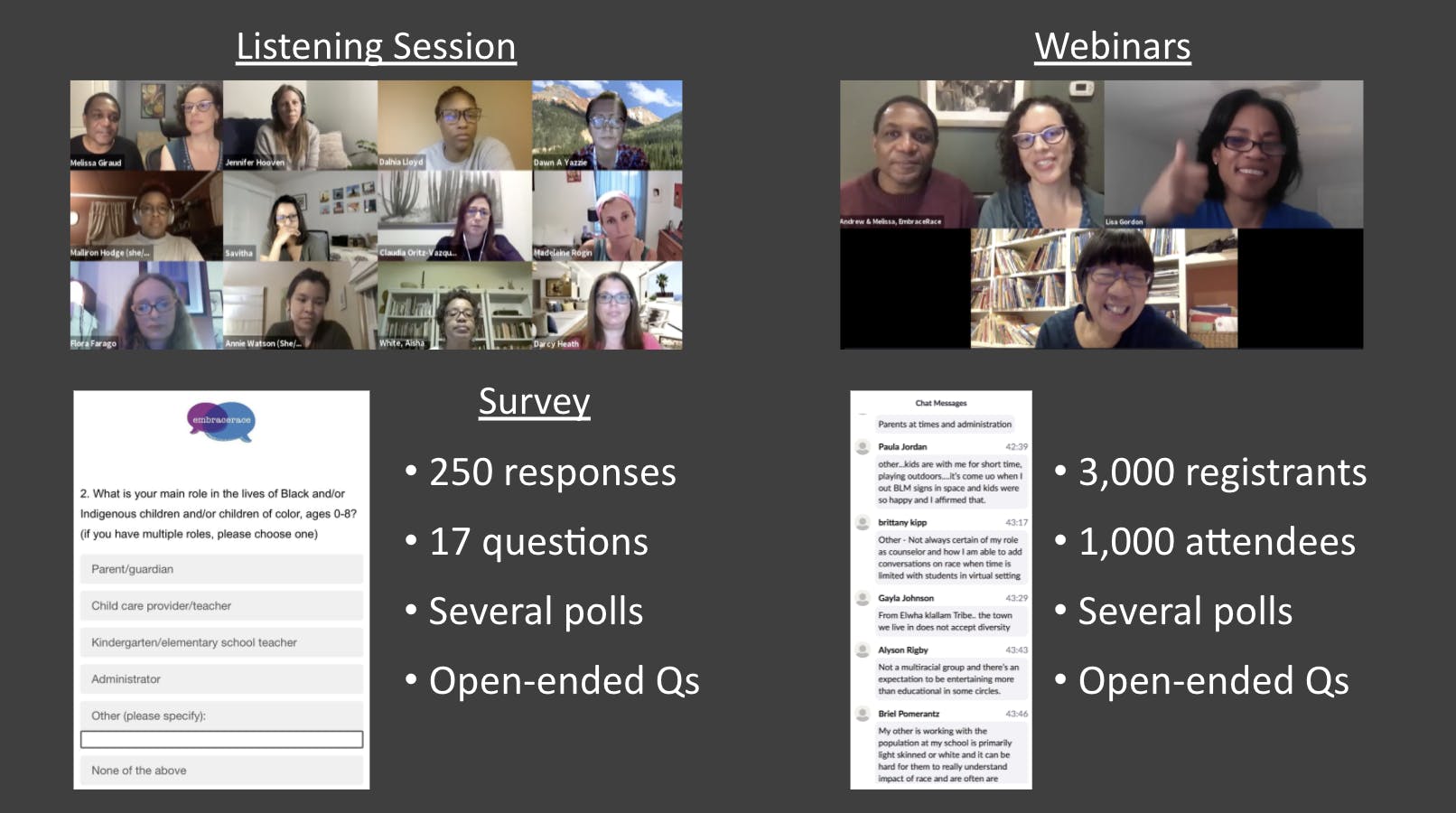
Andrew, EmbraceRace: We have a number of sort of formal sources of information. Formal efforts to gather information insights from people like most of you who are listening now and watching now. First, in October of last year, we had a listening session. Across all the things I'm going to show you, it was about reaching out to the parents, the guardians, the grandparents, the teachers, the principles, the program coordinator. All the folks across, again, birth through eight years old, and of all racial and ethnic strides to see, what is it that you need? Is there demand for this? How can we support you?
So, listening session was one. Then we had two webinars in the middle of November, I believe. 3,000 registrants across the two of them, 1,000 attendees across the two. It was about, how do we nurture resilience and joy in BIPOC children? The first webinar focused on the parent and family perspective. The second webinar, which is what this screenshot is from, on the educator perspective. That's Debbie LeeKeenan for those who know her, and Lisa Gordon. The guests in each case weren't the only sources of information, as fabulous as they were. Again, these thousands of attendees. We polled them. We asked open ended questions a little bit here. You see on the left is just a snippet from the chat. It's not meant for you to read, just to acknowledge that they shared tremendous information in response to the polling and the open ended questions. And just our own observations and resources. We poured through all of that.

Third,
a survey that we did. 250 respondents, 17 questions. You see some of the kinds
of people that we solicited there. Again, parents, guardians, childcare
providers, teachers, and so on, administrators. What did they come up with?
Well, here are some of the questions. This is certainly not exhaustive, but
these are five big questions that were offered in different ways again and
again across all the different groups that we reached out to.
1) Why is it so important to talk about race with children? I mean, that's really baseline. Many of us, probably almost everyone if not everyone participating here, believes that it's important. But why? You might be hard pressed to articulate exactly why. That's an important foundational question to begin with.
2) How do I begin to talk with even younger children? Almost all of us have had this challenge, if we've taken it on at all, and recognized the importance of, what's the language I use? What's the concept? What does it mean to be developmentally appropriate? That's something we're going to engage.
3) How can I find support for my own personal work? Darcy, when you were talking about your experience, you said of course you needed to do that. A lot of people in our experience, don't appreciate that they themselves as adults need to do that work to do the work effectively with their children. But a lot of people certainly do and they said, "How do I get support to do that and a safe space to do it?"
4) How do I talk to children of color about discrimination and racism in ways that leave them feeling affirmed and empowered? This is a classic challenge because much of the story of race, of course, is hard. It's a hard story, but you don't want to tell your children that story or tell pieces of that story, and have your children feel defeated in the wake of that. How do you do that?
5) Finally, what can I do to support trust and build collaboration on racial learning between parents and educators? Especially for the youngest children, they spend more or less half their waking hours with you if you're a parent or another person at home, and half with the educators. We need folks to be on the same page.
One thing we heard when we asked adults, "What are some of the obstacles of doing this work?" Many of them said, "Other adults." Parents named educators. Educators named parents. Not just that, but clearly there's work to do to support trust and build collaboration. Then what did it look like? What does community look like? Again, there are other features. But here are five key ones that everyone offered up.

They want the safety, empathy, and confidentiality "to talk about things not talked about." This was something especially offered by BIPOC parents, but it makes sense. They're difficult conversations to be had, or they may be personally challenging. They want space and empathetic ears in which to share what they have to share. A place to normalize race talk, develop vocabulary, and "model imperfection," which is a little phrase that we love. You need practice. You just don't pop up and show up, and suddenly you're perfect with this and comfortable with this.
Where do we practice? Realtime exchanges led by peers leading with important questions. There is a need for wanting to be able to put something out there and hear back immediately, and I want to be able to respond to people and support them in real time. That came up repeatedly. Structured activities. Listen, people are busy. We're all really busy, so it's not enough to have a regular Facebook group where you go in and you're not sure what you're going to get. Although there's certainly a place for those, they wanted to define focus, bounded time. What's the work? This is work. We want to build relationships, but we know it's work. Let's make it that so that we know it's worth our time.
Finally, affinity and non-affinity groups. By affinity groups, what they were saying very clearly isn't only racial ethnic affinity groups, although that's important. But it's also around issues. I want to talk to people who want to talk about the issues that matter to me, or I want to talk to people who also have preschool boys of color, or whatever it might be. But they're also clear about non-affinity groups. They also want to engage people who they don't normally get to engage with in their usual day to day, including parent teacher.
Then we turn to you, Keeley. The question is, okay, so we have that sort of form of the community and we have some questions. What does it actually begin to look like?

Keeley Bibins: Great, so I get to discuss what it looks like. All right, so here's kind of what it looks like. We have this big Color-Brave community, which is the big encompassing circle. Within that, what we're going to do, this is where we're going to have the webinar just like we're having tonight. We're going to have a Color-Brave community with the monthly webinars that are going to happen every fourth Tuesday of the month. It's for everybody. These are for those who want to get to learn and have a conversation on, how do you have these conversations? Kind of like the topics, the questions that Andrew went over. You have, why is it important to talk to children about race? How do we begin to have these conversations?
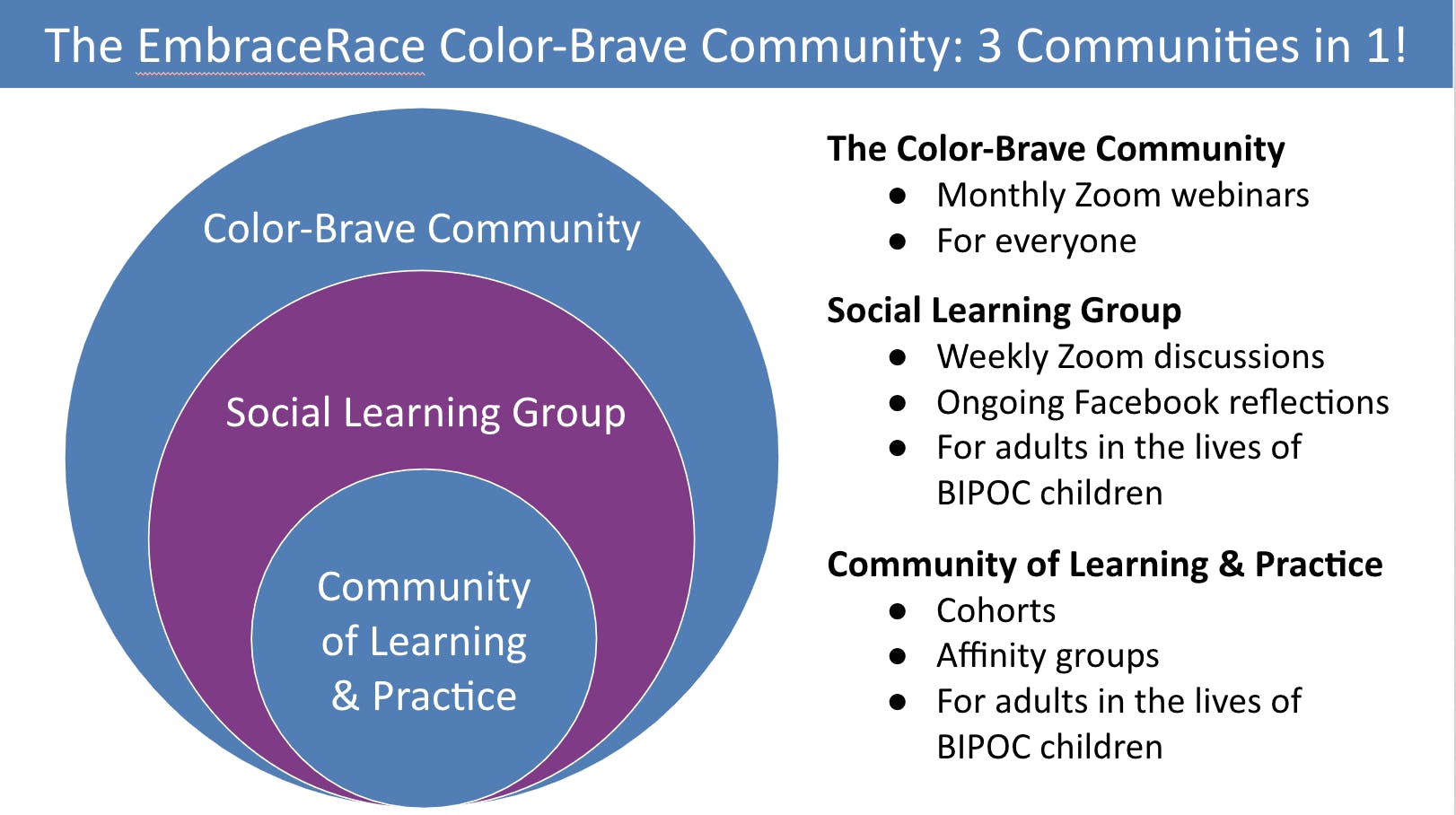
Every month, we're going to have a webinar based on one of those questions. That's going to be the theme. That's that big blue Color-Brave community. Now we're going to come down and we're going to small down a little bit more into that social learning group. Within the social learning group, this is a group that is made, just like Andrew was saying and Melissa, as a response to those who said, "We want to have this confident space where we can talk about our children and caring for our kids." This is going to be for the adults in the lives of our BIPOC children. We're going to have weekly Zoom discussions. That is going to be once a week. We're going to make it different days and times to accommodate the scheduling of our members. It's going to be on Monday. Some will be on Thursday, some will be on Saturdays. Some in the evening, some in the morning, because we all have busy lives. We want to be able to make it available for everyone to join and have those conversations.
Then we're going to have also a Facebook group. The Facebook group is going to be available for you to join even after this webinar tonight. Also, there's going to be that group where you can put in your reflections. You can put in comments based on the theme for the month. Also, we're going to share resources on that Facebook. You can go ahead and look at those resources, read them, and we'll jump on and have conversations. We can have those conversations when we get into those weekly Zoom discussions.
Then last, in that smaller, smaller circle, we have the community of learning. Now, right now, the Color-Brave community is happening right now as we can see in the webinar. Our social learning groups are happening really soon. That weekly Zoom discussion is actually going to start, I think it's the sixth of May is actually the first day. Like I said, the Facebook is going to be available right after the webinar. When we get into the community of learning, we're going to kind of see how things are going further down the line, kind of around July so we know how it's going. We're going to start breaking into smaller groups, which are like our cohorts. These cohorts are going to be offered three times a year. We're going to switch them up.
This is where Andrew was talking about those affinity groups. If you want to have conversations with those that have like experiences, whether it be race, teacher, parent, we're going to break into those. That too is also for the adults who are in the lives of BIPOC children. It's going to start really big and then we're going to get into these smaller groups. Wonderful Ms. Darcy is going to tell you how we're going to get that started.

Darcy Heath: All right. Well, thank you, Keeley. Can I add that to my bio, wonderful Ms. Darcy?
Keeley Bibins: Yes.
Darcy Heath: All right, so I just want to say I saw in the chat box a comment that says, "I'm in my kitchen dancing for joy for the creation of the space of the Color-Brave community." I just want to echo that. We are dancing for joy as well. Let's get involved. How are we going to do this?
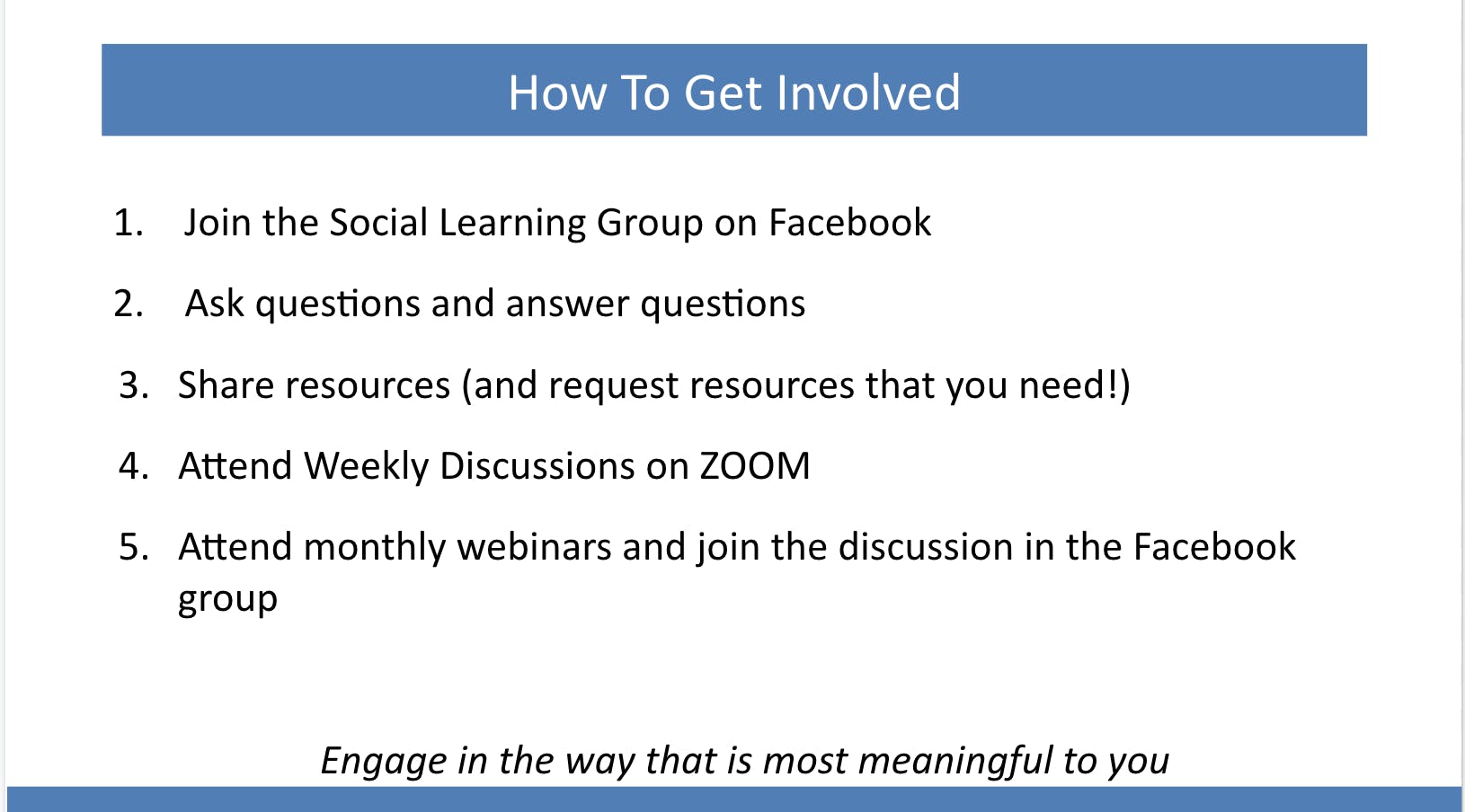
First of all, as Keeley said, we are going to have a Facebook group. We are going to put the link to join that group into the chat box for you, and it'll also be in the email that you receive tomorrow from EmbraceRace when they send out the recording. A couple things to know about the group. It is a private group. It's about protecting that space for us. The space where we can go, and we can engage in conversation. We can ask the questions and we can practice that imperfectly. Anything that you post on your membership in the group will not show up on your Facebook timeline. Other people won't see your comments. We do want you to know that it is a private place.
In order to create that space and brave space for us, we do have some vetting questions. When you click on it, you're going to be asked to answer some questions. That's really about us maintaining the focus of this group, but also maintaining the safety of all of the members. Along those same lines, we are going to provide some community norms that we expect people to follow. Those community norms will be available to you as well. How can you get involved? How can you engage? Well, first of all, use that space to ask those questions and answer the questions. Share the resources that you have that are meaningful and purposeful for you, and request the resources that you need. There will be great wisdom in this group. Keeley and I are the facilitators. We are not the teachers, the leaders. We are simply there to facilitate the wisdom that each one of you is going to bring into the community.
As Keeley said, we're going to have those weekly discussions on Zoom so that we can dive deeper into a conversation. It might be around a question that came up from the monthly webinar. It might be around a question that one of you has asked in our community. Those will be an hour long each week. Come to the ones you can. No expectation that you come to all of them. Also, during those weekly discussions, we'll have the opportunity to be on a different platform than webinar. In webinar, we can't see one another's faces. That's hard to build community. Those Zoom discussions will be held in Zoom meetings, which will allow us to see one another, to connect on a human basis and build relationships. We'll have the opportunity to talk in large groups as well as in smaller groups in there.
Then of course, our monthly webinars are going to be full of fascinating information. The main thing with this group is, engage in the way that is most meaningful to you. Not all of it is going to speak to you and that's okay. You can be a part of this group without committing to all of these things. Maybe there's just one thing that you would like to commit to, that's great. Then our weekly discussions. Our first one, as Keeley has already said, is going to be on Thursday, May 6th. For the first month it's really going to be about, let's get to know one another. With that, Keeley and I will start with letting you get to know us.

We're doing some Q&As. You can get more information about the group. You can ask us more about our personal experiences, whatever it is that comes up for you. That will be, as I said, Thursday, May 6th at 7:30 P.M. Eastern. From 7:30 to 8:30, or 4:30 P.M. to 5:30 P.M. Pacific time. The links to those groups will be available in the Facebook group. I did see a chat that said something about, "Can we be involved other ways?" There will be an email that we can reach out to. We encourage you to reach out to Keeley and I, and we can get you those Zoom links so you can still be a part of those discussions if you would like.
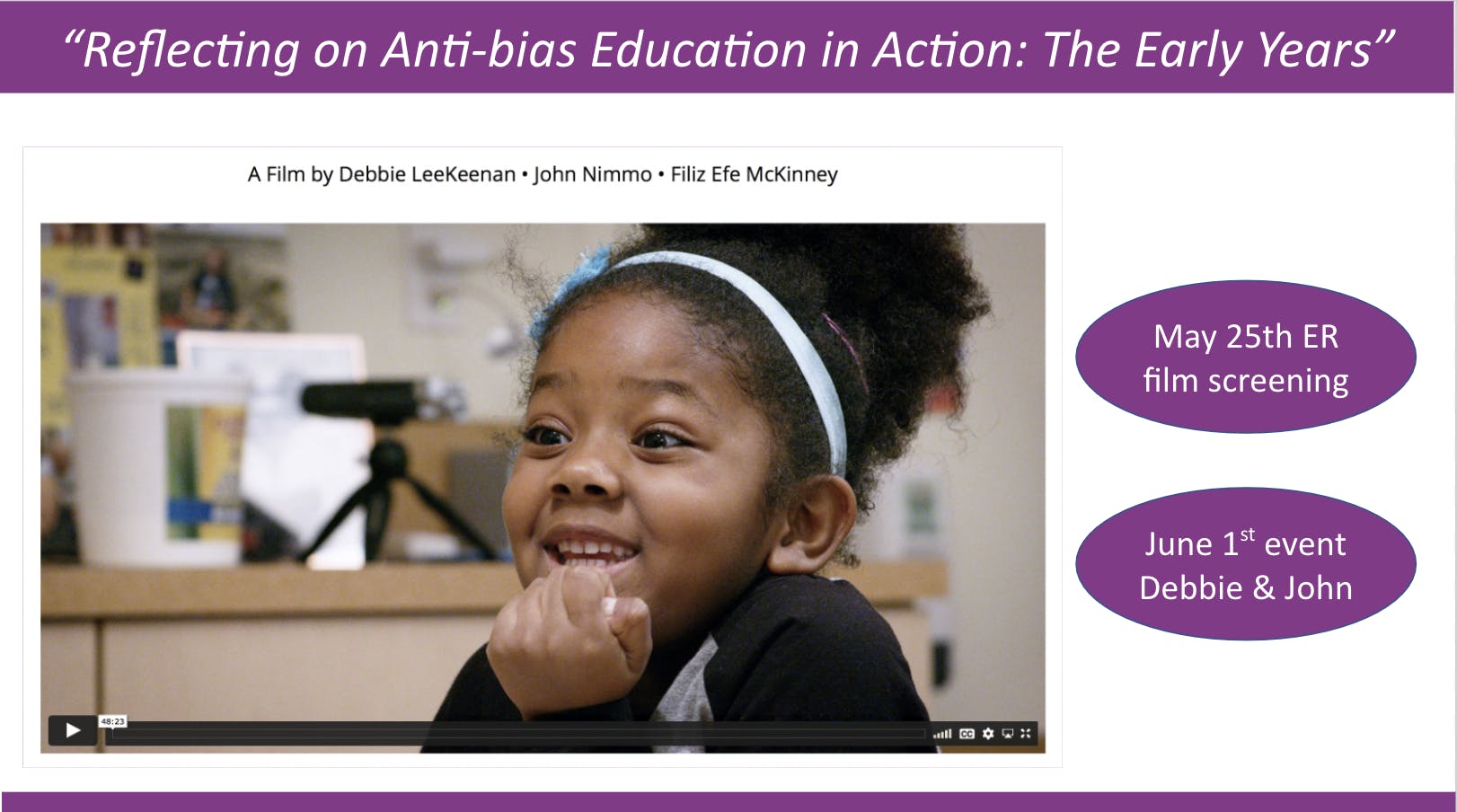
Finally, what are we doing from here? Like I said, we're going to get this Facebook group started. We're going to build relationships, and then our next webinar will be May 25th. It is one I am extremely excited about. Debbie Lee Keenan and John Nimmo have created a wonderful film full of vignettes of, what does anti-bias education look like in the early years? They will be joining us on the 25th for a film screening. Then they will be returning to our weekly discussion on June 1st. They will be our special guest. Our Color-Brave community will have the opportunity to engage in them in a question and answer in a smaller setting. That's how we're getting started now. We look forward to having each of you be a part of that with us. You can reach out to Keeley and I at ColorBrave@EmbraceRace.org to get any more information or support if you have any additional questions.
EmbraceRace, Melissa: Great, that sounds amazing. Just hearing you describe it, I'm totally sold.
EmbraceRace, Andrew: I want to read one comment. It's a comment rather than a question, but it does raise one key question that we're already getting which is about who should be involved in this. This is from Brianna. "Looking forward to connecting with people who share similar values and hopes for future generations. I don't have children, but I'm the Assistant Director of an early childhood center in Chicago. Hoping to learn a lot and bring things back to my staff and school to make us better individuals and educators." That's fabulous. I'm sure that we've emphasized, drawn a line under parents and family members, including grandparents or aunts and uncles, educators, understanding that very broadly.
I'm sure there will be some of you, or others who might join or are interested in this work, or wonder, well, do I have a significant enough relationship to pass that threshold? This is actually something we haven't talked about in great detail, so I'd like to invite my colleagues to weigh in. My take is that we'll leave it to you really to make that judgment. We're looking for people who have meaningful relationships with BIPOC kids. If that's you, I would say you're very welcome. What's your thinking? Anymore guidance you can give folks?
EmbraceRace, Melissa: No. I think it's a community and a commitment to do some work, so you probably have to have that relationship to want to do it in the first place.
Darcy Heath: I would like to add to that, to stress that this is for both for our families and caregivers and extended families, but it's also for the educators who are working with young Black, Indigenous, and other children of color. This space is for you as well to come and learn. Learn from other educators, but also learn from families about what you can do to support the children that you care for.
Color-Brave is for both for our families and caregivers and extended families, but it's also for the educators who are working with young Black, Indigenous, and other children of color. This space is for you as well to come and learn. Learn from other educators, but also learn from families about what you can do to support the children that you care for.
Darcy Heath
EmbraceRace, Melissa:
That's absolutely right. In fact, EmbraceRace, we sort of started it after a
meeting with parents and teachers, and realized just how much we weren't
hearing about the teachers' struggles, and the assumptions we were making about
each other. We really want to stress that it's both. We're getting several
questions like this. Stephanie says, "I am so excited about this.
Wondering if it's too late for people to join who are not here tonight. My
school's equity committee is meeting tomorrow night, and I would love to give
them the invite." And other questions as well, related. "I'm a higher
education faculty member. How can I support pre-service and current teachers in
supporting their own growth in this area?"
If you have people in your circle you want to join Color-Brave, or people who weren't on this call tonight, can they still join?
EmbraceRace, Andrew: Absolutely. To be fully transparent, here's a way this team is thinking about it. We know there will be hiccups. We know that we will not be as strong, as robust. We won't have everything online from the beginning. Part of that frankly is that the community that joins will have a significant say in how the community looks and how it goes. We will certainly do our best, of course. But we will be as strong as the participants make us. Our thought is, to start off, we have not thrown the doors wide open in terms of invitation by any means.
We hope that in some number of months, and we think we'll know it when we see it or maybe we'll start some specific benchmarks. But in some number of months when we feel like, okay, we've got this. We feel good. The community feels good. Then we'll open up the doors and invite in far more people. Now, that doesn't directly answer the question of what to do right now. I would say that if you have folks who are ready to go, who just can't wait to get started, come on in.
EmbraceRace, Andrew: Let me go to you, Keeley. Any thoughts about that?
Keeley Bibins: No, I think you guys summed it up very, very nicely. Like I said, I'm really excited. I'm glad Darcy did say, "Educators, this is for you too." Because one thing is, even subbing today in the classroom, it's great. But you have different children with different needs, different strengths. To have that parental support, parents are the expert on their children. You're never going to know their child better than them. To be able to take that expertise and bring it into the classroom to create a successful environment, I'm really looking forward to it.
Like you said, I'm hoping that we get family members. Because even as an educator, we have grandparents. I have a father who would love to have conversations, his biracial children and his grandchildren. Having not only just parents, but family members as well as educators all learning together to bring this cohesive amount of learning to take back home and to take into schools. So that the children can move and transition smoothly between the two.
EmbraceRace, Andrew: Darcy, did you want to add anything to this piece?
Darcy Heath: No. Again, I'm going to go ahead and rest on your answer and Keeley's answer. I think that summed it up.
EmbraceRace, Melissa: As Darcy said, tomorrow, you'll see an email from us with Facebook link, the email, ColorBrave@EmbraceRace.org for more information and the recording. You can forward that on to people, absolutely. They can figure out what the best way to contact us, or if they want to go straight to Facebook, that's what we'd recommend.
EmbraceRace, Andrew: Another question that we've rarely been asked, but I'm glad this person, this anonymous attendee, is asking it.
How are we funding this amazing work?
Great question. There are two main ways in which this is being funded. One by individual donations. Typically small donors giving one time donations on our website typically. We have monthly donors. That's one way. The other way is through foundations. The two foundations supporting us now in early childhood work specifically are the Heising Simons Foundation, their focus is early childhood. They have been incredibly supportive of this work and our expanding sort of early childhood portfolio. And the LEGO Foundation, as in the LEGO Community Fund. They make the bricks that so many of us grew up with.
EmbraceRace, Melissa: That so many of us step on and also enjoy.
EmbraceRace, Andrew: Yeah, and get embedded in our heels. They're making up for that. Not really.
EmbraceRace, Melissa: That was funny.
EmbraceRace, Andrew: Those have been the two major early childhood funders.
EmbraceRace, Melissa: Someone asked, "I'm looking for ideas on how to recognize inequity, and how to create greater equity in my pre-K classroom." That's such a great frame, is how do I recognize it? Because that is really the thing, is that we so often just learn to not see what we see just to sort of get along, because the normalizing is just such a prevalent sort of response in our school systems. You are ahead of the curve by wanting to learn to recognize something you might not recognize in this moment. I wonder if anyone has a response to that as well.
Keeley Bibins: I would say if possible, if you have the opportunity to work with colleagues or people in the school, or staff in the school that are people of color to be able to reflect with, if you have that kind of coach. One, if that's possible. Two, it's opportunities just like this. Join yourself with opportunities where you're able to learn, looking at discussions. The more you learn, the more you read. You'll start seeing things differently. The more you become aware of what it could look like, I think that you'll go into the classroom, start noticing, and asking those questions. But it's good to have some type of support or someone that you can ask to reflect with or to ask the questions. Even if it is not a colleague at work.
If you have friends of different nationalities or races in your personal circle. Asking those type of questions. But it really all starts, like Darcy said, it starts with yourself first. Once you start looking at having those conversations, learning, reading, joining this group and having this conversation with us. Then you will be able to start looking at your own biases, like Darcy said. Don't get me wrong, I should have mentioned it too. I have some, I do. But looking at those, and then you'll start seeing things in the classroom just a little differently.
Darcy Heath: Just a quick shout out to our webinar on May 25th. That is going to be a wonderful introduction to what anti-bias education looks like. It's about equity. Debbie Lee Keenan and John Nimmo do a wonderful job of really explaining the different four core goals of anti-bias education, as well as showing some beautiful vignettes of what it might look like. As a starting place on this journey, I would definitely encourage you to take a look at that.
EmbraceRace, Andrew: I'll just have to share this, talk about shout outs, from Melissa. "We are greatly blessed to be able to work with Keeley professionally and maintain a personal relationship with her as well. I know that if she is involved, it will be informative, quality, and inspiring. I'm very thankful to receive this insight and look forward to participating." Several people have already said that they put in their Facebook group requests.
Keeley Bibins: Thanks, Melissa.
EmbraceRace, Andrew: Thank you, everyone.
EmbraceRace, Melissa: Yeah.
EmbraceRace, Andrew: I think we are a bit early. I'll give just one minute to see. I think we have answered most of the questions, all the questions that speak to what this community is about and some of the logistics. Again, I'm repeating this just because it's often lost. We always send you, if you're registered, whether you're here or not. Obviously if you're not here, you're not hearing me now. But people register even if they can't make the live time because we send a link to the recording and the transcript, and any other relevant information, including resources that come up to you thereafter. As Melissa said, feel free.
I got an email from someone today saying that she had family members who would love this, but they weren't able to come. By all means, share. As Melissa said, share the things that we send you with others that you think might be interested. Don't be alarmed to see that we, again, don't advertise this widely right now. We are going to learn and get better and grow together. Then at some point, if all goes as we hope it will, that time will come.
Darcy and Keeley, thank you, thank you, thank you for sharing your time and really for sharing. You're very modest. You are facilitating the community. Yes, we do expect the benefit to everyone who participates to come from other participants. Don't let these people fool you. We didn't just handpick on the street, you all. So, look forward to next time.
EmbraceRace, Melissa: Right. You'll be getting that email, and yeah. The webinars, the monthly webinars, will be open just for people who already come to our webinars, we saw some of that in the chat, people say they come, are going to be open to the whole EmbraceRace community. They'll be very much like other webinars. You can go to the ones, the fourth Tuesday. But there are others during the month as well, so continue to attend as many as you want. There's one that will in particular be discussed later in your groups as part of the Color-Brave community.
EmbraceRace, Andrew: Thank you, folks, for participating. Thank you Darcy, Keeley, language justice interpreters, Chris. Everyone who made this possible, and everyone who will make possible work that we're going to create together. Thank you so much. Until next time.
Color-Brave Community Facilitators
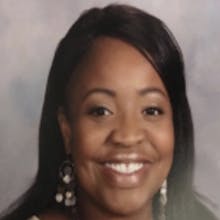
Keeley Bibins
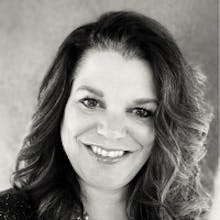
Darcy Heath
Get Insights In your Inbox
Join the EmbraceRace community! You will receive the newsletter with our latest on race & kids, including upcoming events and opportunities, resources, community news and curated links.
Subscribe


